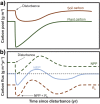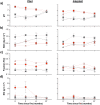Multiscale responses and recovery of soils to wildfire in a sagebrush steppe ecosystem
- PMID: 36575205
- PMCID: PMC9794722
- DOI: 10.1038/s41598-022-26849-w
Multiscale responses and recovery of soils to wildfire in a sagebrush steppe ecosystem
Abstract
Ecological theory predicts a pulse disturbance results in loss of soil organic carbon and short-term respiration losses that exceed recovery of productivity in many ecosystems. However, fundamental uncertainties remain in our understanding of ecosystem recovery where spatiotemporal variation in structure and function are not adequately represented in conceptual models. Here we show that wildfire in sagebrush shrublands results in multiscale responses that vary with ecosystem properties, landscape position, and their interactions. Consistent with ecological theory, soil pH increased and soil organic carbon (SOC) decreased following fire. In contrast, SOC responses were slope aspect and shrub-microsite dependent, with a larger proportional decrease under previous shrubs on north-facing aspects compared to south-facing ones. In addition, respiratory losses from burned aspects were not significantly different than losses from unburned aspects. We also documented the novel formation of soil inorganic carbon (SIC) with wildfire that differed significantly with aspect and microsite scale. Whereas pH and SIC recovered within 37 months post-fire, SOC stocks remained reduced, especially on north-facing aspects. Spatially, SIC formation was paired with reduced respiration losses, presumably lower partial pressure of carbon dioxide (pCO2), and increased calcium availability, consistent with geochemical models of carbonate formation. Our findings highlight the formation of SIC after fire as a novel short-term sink of carbon in non-forested shrubland ecosystems. Resiliency in sagebrush shrublands may be more complex and integrated across ecosystem to landscape scales than predicted based on current theory.
© 2022. The Author(s).
Conflict of interest statement
The authors declare no competing interests.
Figures






References
-
- Gorham E, Vitousek PM, Reiners WA. The regulation of element budgets over the course of terrestrial ecosystem succession. Annu. Rev. Ecol. Syst. 1979;10:53–84. doi: 10.1146/annurev.es.10.110179.000413. - DOI
-
- Corman JR, et al. Foundations and frontiers of ecosystem science: Legacy of a classic paper (Odum 1969) Ecosystems. 2019;22:1160–1172. doi: 10.1007/s10021-018-0316-3. - DOI
-
- Kominoski JS, Gaiser EE, Baer SG. Advancing theories of ecosystem development through long-term ecological research. Bioscience. 2018;68:554–562. doi: 10.1093/biosci/biy070. - DOI
Publication types
MeSH terms
Substances
LinkOut - more resources
Full Text Sources
Medical

